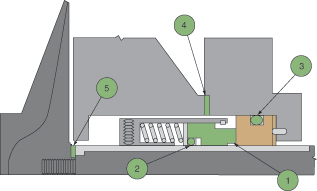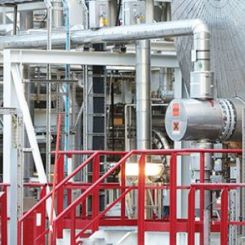Q. What are the typical causes of mechanical seal failure in rotodynamic pumps, and what are the possible leakage paths?
A. A mechanical seal is expected to achieve its maximum mean time between planned maintenance (MTBPM) when it is operated within its design specifications. A seal is considered to have failed when leakage exceeds environmental or plant-site operating limits. Failure may occur before or after the seal has achieved its design life expectancy. Seal failure may be a major contributor to equipment failure and downtime.
Understanding the mode of seal failure can lead to extending rotary equipment life by improving seal design and material selection, installation and operating procedures and environmental controls.
The failure of a seal may be the result of:
- Incorrect seal design or material selection for the application temperature, pressure, speeds and fluid properties
- Seal component abuse before installation—including chipping, scratching, nicking or allowing to become dirty
- Erroneous installation—including assembly, seal setting or placing of components in the chamber
- Improper start-up, dry-running or failure of environmental controls
- Improper pump operation
- Contamination of the sealing fluid with abrasive or corrosive materials
- Equipment with excessive shaft runout, deflection, vibration or worn bearings
- Worn out seal—the seal achieved its normal life expectancy
A single-stage mechanical seal may leak along one of five paths (see Figure 23.1).
- Seal face leakage is visible where the shaft exits the gland or at the drain connections.
- Dynamic secondary seal leakage is visible where the shaft exits the gland or at the drain connections.
- Static secondary seal leakage is visible where the shaft exits the gland or at the drain connections.
- Gland gasket leakage is visible at the gland-seal chamber interface.
- Hook sleeve gasket leakage or cartridge sleeve secondary seal leakage is visible where the sleeve ends outside the seal chamber.
Additional information on troubleshooting mechanical seals can be found in Mechanical Seals for Pumps: Application Guidelines [A132].

Figure 23.1 Possible seal leakage paths
Q. How can rotodynamic pumps be monitored to ensure that the original pump efficiency is maintained?
A. Increased leakage loss is a main cause of reduced efficiency and head. Leakage losses also cause increased NPSHR.
Internal leakage losses are a result of differential pressure across the clearance between the impeller and the pump casing. Larger internal clearances result in greater internal leakage, therefore increasing the efficiency losses. The normal clearance in a new pump ranges from approximately 0.35 millimeter to 1.0 millimeter. As the clearance increases, the leakage increases almost linearly with the clearance. For example, a clearance of 5 millimeters decreases the efficiency by 7 to 15 percent in closed impellers and by 10 to 22 percent in semi-open impellers. This effect decreases with increasing specific speed.
The most critical factors that affect pump efficiency because of leakage losses are:
- Abrasive characteristics of the liquid
- Materials of construction of the parts on each side of the clearance
- How the worn clearance can be restored to the original dimension
Some slurries are obviously abrasive. Other liquids that are not normally considered abrasive can also cause clearance wear. For example, sewage and rainwater can be abrasive due to their sand content.
Wear Monitoring
In principle, the effect of wear can be monitored by measuring pressure and flow. The effects of large changes within the piping system and large amounts of internal leakage can be easily seen. However, in practice observing small changes in head, rate of flow and efficiency is difficult because of the insufficient accuracy the head and rate of flow curves and of the measurement methods or instruments. Additionally, the resistance curve of the system piping may change with time.
The most practical way to monitor the impeller-to-casing clearance is by direct measurement during periodic maintenance inspections. The interval of the measurement may be determined by historical pump performance degradation data.
In general, if the clearance can be easily adjusted, the adjustment should be made when the gap is approximately 2 millimeters (0.08 inch). If the clearance cannot be adjusted without replacing parts, the break-even point may be about 3 millimeters (0.125 inch) or as recommended by the pump original equipment manufacturer (OEM). For a more accurate determination, an economic evaluation can be performed.
Vibration Monitoring
Monitoring the overall vibration of the pump can detect needless wasted energy. Vibration increases when:
- The impeller has been damaged as a result of impact by a solid object, significantly reducing pump efficiency
- The pump is clogged, and the blockage causes vibration because of a mechanical or a hydraulic imbalance, with decreased efficiency the obvious result
- The system piping or valves may be blocked and efficiency will decrease; some pumps (for example, vortex pumps) may not vibrate in this case, but energy will still be wasted
- The pump is operating outside its preferred operating region
- Suction conditions are inadequate
Pressure and Flow Monitoring
Pressure and flow measurements can indicate:
- Damaged or loose impeller
- Clogged or gas-filled pump
- Blockage or leakage in the system piping
- Closed or blocked valve
- Heavily worn-out pump
Current or Power Monitoring
Motor current monitoring can also be used to indicate breakage, blockage within the pump or trapped gas. Current monitoring may also indicate system problems, such as blocked or heavily leaking piping, provided that the power/rate of flow curve is sufficiently steep. In addition, liquids with high solids content may cause wedging in the impeller clearance, creating increased power intake and decreased efficiency. This may be observed by monitoring motor current or power. Both power and current monitoring are easy to install because they are installed at the control panel.
Thermodynamic Pump Performance Testing
The thermodynamic method is used to evaluate pump performance on site. The main attractions of this technique are:
- Efficiency and performance can be determined on site.
- The equipment is relatively easy to install.
- Testing can be conducted with minimal disruption.
- It does not rely on installed flow metering equipment.
Pump efficiency is determined from measurements of the differential head and temperature rise across the pump and using information on the thermodynamic properties of the liquid being handled. If the power absorbed by the motor is also measured, then with the drive efficiency, the rate of flow can be determined and a set of pump performance curves produced.
The measured temperature rise is small and is a function of the head developed by the pump and its efficiency. The technique can be routinely applied to pumps in which the head rise is greater than 20 meters (66 feet). When the head is between 10 meters (33 feet) and 20 meters (66 feet), installation effects are important. The technique is not suitable for situations in which the head rise is less than 10 meters (33 feet).
The cost of onsite testing should be balanced with the potential savings that can come from improving pump system performance and efficiency. In general, a sound financial case can be made for pumps in which the motor input power is greater than 100 kW.
Pump Life Cycle Costs: A Guide to LCC Analysis for Pumping Systems [M130] contains additional information on minimizing life-cycle costs.
Pumps & Systems, May 2012

